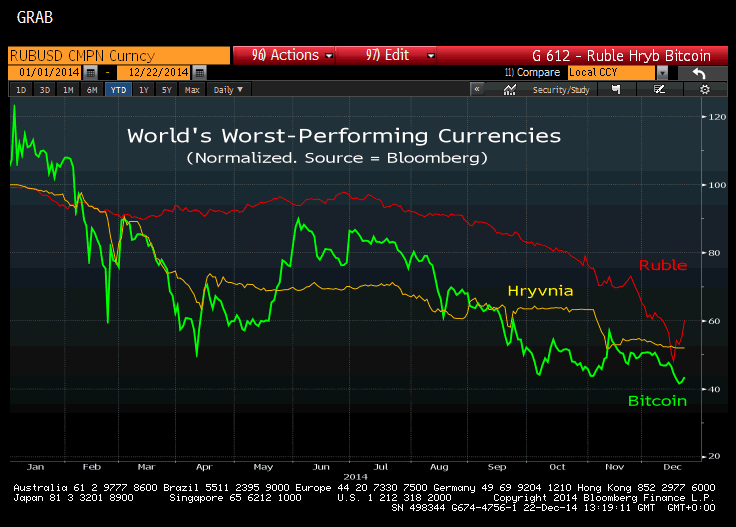At year-end, the world's three worst-performing monies are, (3) the Russian ruble, (2) the Ukrainian hryvnia, and, taking the cake--(1) the hapless Bitcoin. Bloomberg charts don't lie:
The accompanying write-up offers all she wrote:
The digital currency peaked at a value of $1,130 just over a year ago. Its plunge of more than 56 percent in 2014 makes it the world's worst performing currency this year, according to Bloomberg, which tracks 175 foreign-exchange values...I hope to explore some of the reasons why I believe that Bitcoin is another victim of (likely short-lived) dollar strength, but that's a topic for another post. Anyway, let's try to forget about the Eastern European mess and focus on the magic of Christmas since others' currencies have done rather better. Do you believe in magic? The world's best-performing currency of 2014 is, of all things, the Somali shilling:
At a current value of about $326, Bitcoin isn't dead, yet it may be mortally wounded. The Dec. 20 sentencing of Charlie Shrem, one of the digital currency's most vocal cheerleaders as vice-chairman of the Bitcoin Foundation and chief executive of an exchange called BitInstant, to two years in prison for illegal money transfers doesn't help.
While innovation should always be encouraged, Bitcoin isn't yet fit as a place for orphans and widows to shelter their nest eggs -- although there are admittedly plenty of gold bugs who would say the same about fiat currencies.
Here’s a pecuniary peculiarity to rival Bitcoin – the world strongest currency over the past 12 months belongs to a small, war-torn African state without foreign currency reserves or any discernible monetary policy and a central bank of only three years’ standing. Yet the Somali shilling, Somalia’s official currency, has overcome such disadvantages to appreciate against the US dollar by just under 60 per cent since March last year, becoming the strongest among global 175 currencies tracked by Bloomberg. Its surge has been so pronounced that the second most robust currency over the same period – the Icelandic Krona – could only manage a measly 10.2 per cent rise.
The key chart is above even if it's a bit dated. Note that its direction is opposite to the one above since it's expressed in USD/SOS terms. That is, a falling exchange rate means a strengthening Somali shilling. It all reminds us that issuing fiat currency is a confidence game--one that Somalia is winning against all odds as it regains a very slight semblance of normalcy (i.e., statehood) while such normalcy flees from Russia and Ukraine:
The key lesson, though, is that money remains at heart a confidence trick. Minor things, like being backed by a country or countries, being minted by a government, and having a physical form you can put in your pocket, still matter. All of which could come into sharp focus the day hackers reduce our checking-account balances to zero, the financial system crashes into chaos and the fragility of the world's banking infrastructure is laid bare for all to see. Let's hope 2015 isn't the year when we find out that zeroes and ones in a computer aren't really money.In a few more hours, Christians will celebrate the birth of the savior. Make no mistake: there is a long list of developing world currencies that need "saving" in the coming year.Former Soviet bloc nations have it especially bad so those Orthodox churches should be packing 'em in the pews with those wishing for divine (currency) intervention.



Join This Site Show Konversi KodeHide Konversi Kode Show EmoticonHide Emoticon